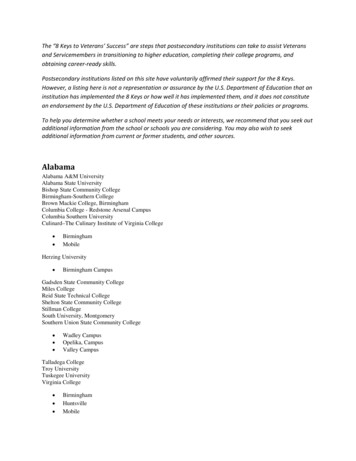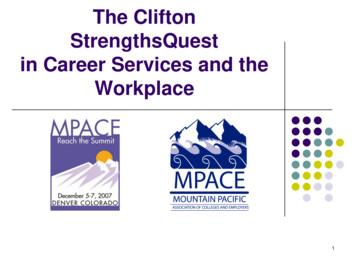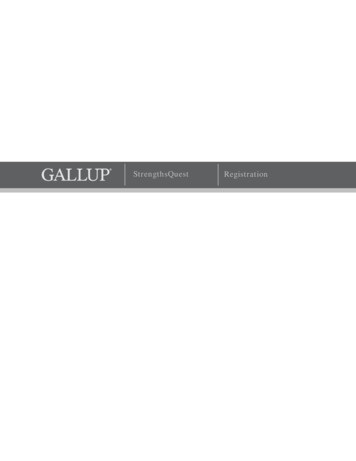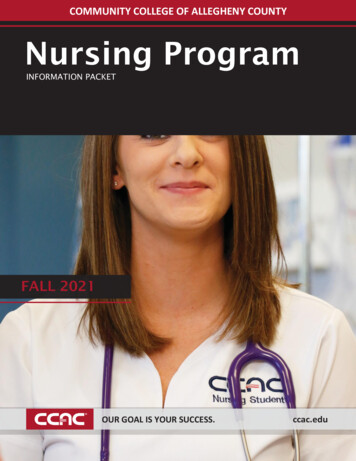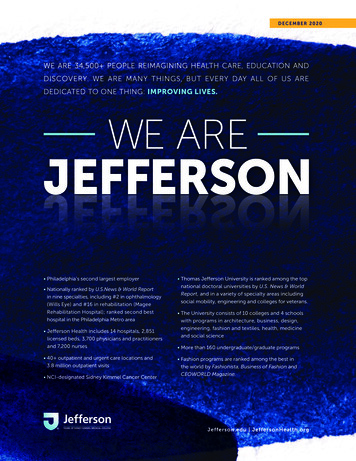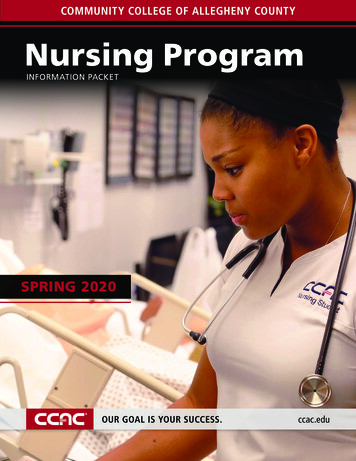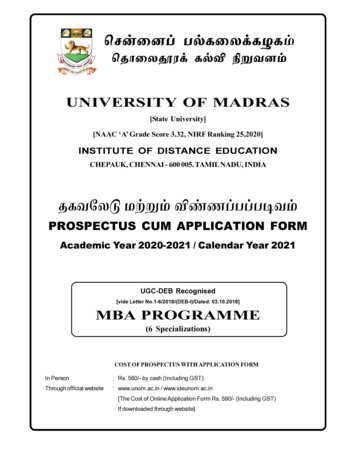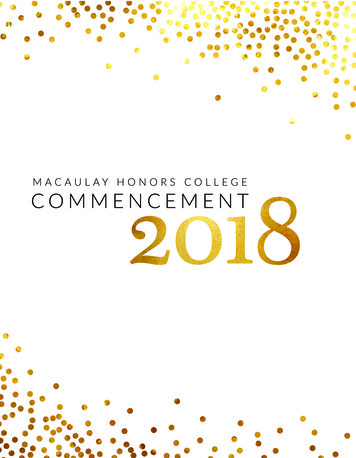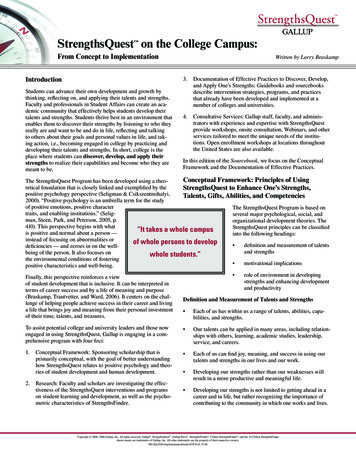
Transcription
StrengthsQuest on the College Campus: From Concept to Implementation IntroductionStudents can advance their own development and growth bythinking, reflecting on, and applying their talents and strengths.Faculty and professionals in Student Affairs can create an academic community that effectively helps students develop theirtalents and strengths. Students thrive best in an environment thatenables them to discover their strengths by listening to who theyreally are and want to be and do in life, reflecting and talkingto others about their goals and personal values in life, and taking action, i.e., becoming engaged in college by practicing anddeveloping their talents and strengths. In short, college is theplace where students can discover, develop, and apply theirstrengths to realize their capabilities and become who they aremeant to be.Written by Larry Braskamp3.Documentation of Effective Practices to Discover, Develop,and Apply One’s Strengths: Guidebooks and sourcebooksdescribe intervention strategies, programs, and practicesthat already have been developed and implemented at anumber of colleges and universities.4.Consultative Services: Gallup staff, faculty, and administrators with experience and expertise with StrengthsQuestprovide workshops, onsite consultation, Webinars, and otherservices tailored to meet the unique needs of the institutions. Open enrollment workshops at locations throughoutthe United States are also available.In this edition of the Sourcebook, we focus on the ConceptualFramework and the Documentation of Effective Practices.Conceptual Framework: Principles of UsingThe StrengthsQuest Program has been developed using a theoretical foundation that is closely linked and exemplified by theStrengthsQuest to Enhance One’s Strengths,positive psychology perspective (Seligman & Csikszentmihalyi,Talents, Gifts, Abilities, and Competencies2000). “Positive psychology is an umbrella term for the studyof positive emotions, positive characterThe StrengthsQuest Program is based ontraits, and enabling institutions.” (Seligseveral major psychological, social, andman, Steen, Park, and Peterson, 2005, p.organizational development theories. The410). This perspective begins with whatStrengthsQuest principles can be classified“It takes a whole campusis positive and normal about a person —into the following headings:instead of focusing on abnormalities orofwholepersonstodevelop definition and measurement of talentsdeficiencies — and zeroes in on the welland strengthsbeing of the person. It also focuses onwhole students.”the environmental conditions of fostering motivational implicationspositive characteristics and well-being.Finally, this perspective reinforces a viewof student development that is inclusive. It can be interpreted interms of career success and by a life of meaning and purpose(Braskamp, Trautvetter, and Ward, 2006). It centers on the challenge of helping people achieve success in their career and livinga life that brings joy and meaning from their personal investmentof their time, talents, and treasures. role of environment in developingstrengths and enhancing developmentand productivityDefinition and Measurement of Talents and Strengths Each of us has within us a range of talents, abilities, capabilities, and strengths.To assist potential college and university leaders and those nowengaged in using StrengthsQuest, Gallup is engaging in a comprehensive program with four foci: Our talents can be applied in many areas, including relationships with others, learning, academic studies, leadership,service, and careers.1. Each of us can find joy, meaning, and success in using ourtalents and strengths in our lives and our work. Developing our strengths rather than our weaknesses willresult in a more productive and meaningful life. Developing our strengths is not limited to getting ahead in acareer and in life, but rather recognizing the importance ofcontributing to the community in which one works and lives.2.Conceptual Framework: Sponsoring scholarship that isprimarily conceptual, with the goal of better understandinghow StrengthsQuest relates to positive psychology and theories of student development and human development.Research: Faculty and scholars are investigating the effectiveness of the StrengthsQuest interventions and programson student learning and development, as well as the psychometric characteristics of StrengthsFinder.Copyright 2000, 2008 Gallup, Inc. All rights reserved. Gallup , StrengthsQuest , Gallup Press , StrengthsFinder , Clifton StrengthsFinder , and the 34 Clifton StrengthsFindertheme names are trademarks of Gallup, Inc. All other trademarks are the property of their respective owners.MS.SQ.SND.ImplementationGuide.ENUS.01.15.08
positive outcomes and individualization, educational professionals spontaneously thinking about and acting upon the interestsand needs of each student and systematically making efforts topersonalize the learning experience” (Lopez, 2004., p. 1).Strengths themselves represent a continuum. All people havestrengths, but in varying degrees. Strengths are not isolated,discrete abilities that are highly innate. Rather, strengths aredeveloped when talents are combined with knowledge andpractice. It is important to avoid dualistic thinking in termsof believing that if a person has strengths, by implicationthey have weaknesses that reflect a mindset of “fixed abilities.” A labeling mentality needs to avoid unintentionallypreventing courage and effort and reducing one’s self-confidence to try new things, persevere, and have the tenacity tokeep going when faced with hardships.In our thinking of human development, we stress that it canbest incorporate a state rather than a trait mind-set. If wethink in terms of a stable, innate, and inherent set of skills,abilities, and talents, then we focus on the trait interpretation. College is the place, however, where we help studentsdevelop their strengths, not just discover what they are goodat or find meaningful. College is primarily a time of exploration for most college students.Talents and themes identified by the Clifton StrengthsFinderinstrument may be considered instrumental to achievement(schoolwork), as well as a desired end in and of itself (e.g.,achievement — working diligently is an outcome of a liberaleducation). Thus, they are both a means and an end. “Colleges and universities that seek to take advantage of newresearch offered through the positive psychology movementwill engage in at least three activities. These institutions will(1) study and understand successful students on campus; (2)establish a campus ethos that facilitates students’ discoveryand understanding of their signature strengths; and (3) assiststudents in finding groups, organizations, or communities thatthey can serve with their signature strengths.” (Shushok andHulme, 2006, p. 5). The campus environment needs to be an “enabling environment,” i.e., a positive organization (Avolio and Luthans,2005). An effective environment is one that fosters positivecharacteristics and well-being. Question 3 of the Q12 instrument, “At work, I have the opportunity to do what I do bestevery day,” reflects this perspective in a work setting, i.e.,people are given many continuous opportunities to excel using their abilities, strengths, and interests. An effective environment is one that intentionally reinforces one’s strengths. Since achieving one’s potential requires an investment ofone’s talents and time, the type of environment that is mosteffective is one that helps a person draw out their inner talents and potential strengths, and to lead a meaningful andpurposeful life. Each person needs assistance — a challenging and socially supportive environment — in discovering,developing, and applying strengths throughout their life.More specifically the types of environmental conditions thatboth support and challenge students are critical. Question11 of the Q12 survey, “In the last six months, someone atwork has talked to me about my progress,” and Question 12,“This last year, I have had opportunities at work to learn andgrow,” both illustrate the importance of an environment thatfosters challenge and support from peers. A campus climate of challenge and support is needed to develop strengths in students. Creating dissonance and providing emotional support to help students master their goals arecritical. If students only focus on talents and not effort, theywe will not achieve excellence in the long run. Selection for“raw talent” is too narrow a view of development. Assisting persons on their journey in life and being an effective worker involves both a developmental and a selection approach. For an organization to be successful, it needs to “getthe right people on the bus,” a basic characteristic of a “goodto great” institution as proposed by Jim Collins in his book,From Good to Great and the Social Sectors. He recognizes theimportance of selection, but he does not stop there. The culture of the institution is critical in going from good to great. Selecting a career is about the right fit, starting with what feelsright and good with the person. Fit is an important factor indeveloping people and having a successful organization.Motivational Implications People are goal-directed and act upon their goals. Their actions and involvement are goal-directed. Building on one’s strengths is motivating. Becoming aware of our talents builds self-confidence andprovides an intrinsic motivation for personally investingone’s own strengths. Discovering one’s strengths is a part of identity formation.As each person progresses through life, they engage in ajourney of becoming their true self. Strengths as developed talents are an appropriate and usefulway to conceptualize human development. It does not reinforce a perspective that some people are just born with talentsand that they do not need to invest themselves — engage inhard work and practice — to exhibit and use their strengths. Applying one’s strengths in service to others is both self-fulfilling and beneficial to society. Thus fostering developmentof strengths meets both the need to aim for common good aswell as individual gain.Role of Environment in Developing Strengths and EnhancingDevelopment and Productivity “The strengths-based approach to maximizing student success, though grounded in historical educational practices, alsois built on two modern-day American educational principles:measurement of achievement, strengths, and determinants of2Copyright 2000, 2008 Gallup, Inc. All rights reserved. Gallup , StrengthsQuest , Gallup Press , StrengthsFinder , Clifton StrengthsFinder , and the 34 Clifton StrengthsFindertheme names are trademarks of Gallup, Inc. All other trademarks are the property of their respective owners.MS.SQ.SND.ImplementationGuide.ENUS.01.15.08
Documentation of Effective Practices to Discover,Develop, and Apply One’s Strengths in StudentDevelopmentStudents take an online assessment instrument that revealsthe students greatest areas of strength.These four interconnected activities and interventions of theStrengthsQuest program all share one commonality — campuseducators need to provide a community of support and challengethat facilitates the “drawing out” of the students’ inner talents,strengths, and gifts. Rather than thinking in terms of pouring“things” into students to reduce their deficiencies, they insteadare engaged in helping students exploit their values, strengths,and sense of self. Thus, leaders focus on creating the environment in which mentors and models provide the type of learningand development environment that will maximally discover,develop, and apply one’s strengths. In this Sourcebook, wesummarize how various campuses have used the StrengthsQuestprogram to enhance the development of students, using strengthsas a core concept in planning the programs.Develop strengths by reading about strengths:Specific Initiatives Using StrengthsQuest on CampusesStudents read the book, StrengthsQuest: Discover and Develop Your Strengths in Academics, Career, and Beyond,by Donald Clifton, Chip Anderson, and Laurie Schneiner(2006), to help them understand their talents, direct them intheir search and development of strengths, and provide themwith insights and strategies on how they can apply their talents and strengths in academic, careers, and life.In this part of the Sourcebook, we highlight five programs inwhich StrengthsQuest is an important part of the interventionstrategy. The five programs are listed below. For each initiative, we provide two types of information to assist you in usingStrengthsQuest on your campus. First, we present some perspectives — often in the form of advice from those with considerableexperience using StrengthsQuest on their campuses. Second,we provide actual PowerPoint slides, course syllabus, and othermaterials to illustrate how campus leaders have designed the intervention on their campus. Each of these is presented with permission of the persons(s) authoring them, and you are welcome toadapt them for your local purposes. We kindly ask that you giveproper attribution to the authors in your own use.Helping students discover, develop, and apply their strengthsrequires a total campus strategy. The Gallup Organization hasdesigned StrengthsQuest to include four major components. Thefirst three are services provided to students by Gallup under thedirection and guidance of the local campus leaders. The last oneis a unique set of activities designed and implemented by eachcampus with possible consultation with Gallup.1.2.3.Discover strengths through the StrengthsQuest instrument:The StrengthsQuest Web site:Students participate in this interactive Web site to learn moreabout their strengths, engage in selected learning modules,and participate in a discussion board.4.Campus programs:1. Student Leadership DevelopmentIn collaboration with Gallup, college campus leaders designand develop curricular and co-curricular programs (workshops, retreats, multiple training sessions) to engage studentsin their discovery, development, and application of theirstrengths. These programs include:1.freshmen year experiences2.relationship-building3.leadership development4.learning communities5.fraternity and sorority groups6.strengths-based advising7.strengths-based teaching8.9.In their own words: Barbara Herman and Cyndi Walsh of Texas ChristianUniversity (TCU) Students in leadership programs at TCUPractices worth noting: TCU Center for Ethical Leadership & ResponsibleCitizenship2. Career Counseling/AdvisingIn their own words: Roderick Hetzel, Susan Hetzel, and Matt Bonow ofBaylor Universitycareer counseling Joe Johnston of University of Missouriprofessional mentoringPractices worth noting:10. peer mentoring Lee University: Vocational Advising Template11. academic classes in the sophomore year12. calling and purpose3Copyright 2000, 2008 Gallup, Inc. All rights reserved. Gallup , StrengthsQuest , Gallup Press , StrengthsFinder , Clifton StrengthsFinder , and the 34 Clifton StrengthsFindertheme names are trademarks of Gallup, Inc. All other trademarks are the property of their respective owners.MS.SQ.SND.ImplementationGuide.ENUS.01.15.08
3. Residence Hallswhat it is to be a leader and how to think critically. We want toget students motivated — to look at creative ways to get theminvested. This is where leading others is an important part of theleadership process. Leading change, which is the third part ofthis model, is connected to positive social change and makingyour mark on the world.In their own words: Michael Shonrock of Texas Tech University Doug Hallenbeck, Missy Bryant, Emily Sandvall, andLeasa Kowalski of Southern Methodist UniversityOur purpose for using StrengthsQuest on TCU’s campus can besummarized by these points:Practices Worth Noting: 4.Southern Methodist University The Strengths-Based Model supports/supplementscurrent leadership theories and practices by:Freshmen-Year ExperiencesIn their own words:a. Debra White of Lee Universityb. Doug Hallenbeck, Missy Bryant, Emily Sandvall, andLeasa Kowalski of Southern Methodist University(SMU)Practices Worth Noting:5. University of Nebraska Lincoln College of BusinessAdministration 101 syllabus Gateway to University Success at Lee University Mustang Corral at Southern Methodist Universityc.Creating a Strengths-Based Culture on CampusIn their own words: Michael Shonrock of Texas Tech University Carl Haynes of Tompkins Cortland Community College Doug Hallenbeck, Missy Bryant, Emily Sandvall, andLeasa Kowalski of SMU Jon Wergin of Antioch UniversityPractices Worth Noting: Tompkins Cortland Community College Greenville College (IL)For each of these five interventions, we introduce the areas withsome perspective from those who have been intimately involvedas leaders and practitioners. Thus, we quote from our interviewswith them, using the heading “In Their Own Words.”1.Providing a framework for understanding self andunderstanding others.Empowering and engaging students —StrengthsQuest is a way for students to talk aboutthemselves to others. There is reluctance bysome students to talk, openly and publicly aboutindividual assets. Thus, StrengthsQuest provides aneffective outlet for students to reveal their strengthsto others and utilize them while working in groups.Offering opportunities for authentic service and civicengagement — StrengthsQuest creates authenticity,greater interpersonal closeness, and cooperation,allowing individuals to use their leadership strengthsto become more sensitive to injustices and abuses inthe world and make a difference. Leadership is relational. StrengthsQuest providesstudents, faculty, and staff with a common languagethat allows for effective advising and mentoring totake place. It also allows for the development of anappreciation of individual strengths and strengths inothers, resulting in increased effectiveness, less conflict,and greater cross-cultural relationships. StrengthsQuest helps students identify ways to becomeinvolved. It allows students to apply their strengths to anyleadership opportunity, job, or career. Thus, we have beenable to utilize StrengthsQuest in a multitude of ways on andoff campus, including residential services, career services,orientation, and leadership training with individual studentleaders, student organizations, academic classes, faculty,staff, and the community at large.Students in Leadership Programs at TCUStudent Leadership DevelopmentIn Their Own Words: Barbara Herman and Cyndi Walsh ofTexas Christian UniversityTCU is unique in that it places students leadership roles and allows students to run with them. Professional staff is there toassist. They are not there to direct. Adapted from the SocialChange Model of Leadership (“lead self — lead others — leadchange”) developed by Astin, we believe everyone has the potential to be a leader and everyone is called to lead in some way.The TCU philosophy of leadership is one in which the first stepis self-awareness. In groups, we encourage students to talk about Our strengths come out in working in groups; thus, it’simportant to have continual interaction with StrengthsQuest,including talking to other students about their own strengthsand getting them to use them. We use the language of strengths in job interviews. It is avocabulary that we have used to impress many intervieweesbecause they realize our ability to know ourselves and toexpress ourselves. It allows us to demonstrate that we knowwhat we are talking about.4Copyright 2000, 2008 Gallup, Inc. All rights reserved. Gallup , StrengthsQuest , Gallup Press , StrengthsFinder , Clifton StrengthsFinder , and the 34 Clifton StrengthsFindertheme names are trademarks of Gallup, Inc. All other trademarks are the property of their respective owners.MS.SQ.SND.ImplementationGuide.ENUS.01.15.08
Practices Worth Noting:The campus culture at TCU is very supportive. It givesstudents the tools to find out who they are. There is aphilosophy on campus of nurturing and helping studentsbecome leaders. It is not a place that forces you to develop inone way, but it provides a supportive community. It is hard toget lost in a crowd.Lee University: Strengths Vocational Advising TemplateThese suggestions cover a variety of scenarios. Choose accordingto the student need and the best fit with your style.Beginning the Session:Practices Worth Noting:I.TCU Center for Ethical Leadership & Responsible Citizenship (www.sds.tcu.edu/leadership)II. Explain the Strengths Talk format and what you hope toaccomplish.This center serves thousands of students, faculty, staff, andcommunity members with skill-based, interactive training andresources that ensure thorough exposure to contemporary leadership topics and theories. The theme of the Center is “You’re aLeader.” Regardless of a student’s chosen major or career path,she has the ability to act and positively effect change in her community. A wide variety of programs are designed to help allparticipants live TCU’s mission statement: to educate individualsto think and act as ethical leaders and responsible citizens in theglobal community.”2.Clarify the purpose of today’s appointment.A Basic Strengths Talk1.What are your top 5 themes? What is the “strength” ofeach one?2.What does each theme enable and empower you to do?In other words, how have you seen these themes at workin your life? When/where have you recently used eachtheme?3.What phrases in the theme paragraphs are true for you?(mark with highlighter)4.Use the handout, “Taking Your Most Dominant ThemeSeriously.”Career Counseling and AdvisingIn Their Own Words: Roderick Hetzel, Matt Bonow, andSusan Hetzel of Baylor UniversityFocus attention on the student. Listen. Take notes on the worksheet as the student speaks and give the student a copy of theworksheet with your notes at the end of the session. Place theoriginal worksheet in the student’s file.We discuss the feasibility of the rule to not go beyond the fivestrengths. Some students have interpreted this rule as if youeither got it or you don’t, and it’s not seen as a continuum ofstrengths. Others of us have concluded that we all use every oneof our 34 themes at some time in our lives; thus, we need to bemore concerned about having it viewed not in terms of a dualisticblack and white, but as an instrument for further exploration.a.Where are you most frequently using your mostdominant strength?(areas, roles, responsibilities)StrengthsQuest, as it fits into the counseling process, can beviewed as a way to create a mindset for people, a way to reframethe problems, and a way to recognize one’s relationships withothers to encourage stories, meaning, and purpose.b.How often are you using your most dominant strength?Weekly, daily, hourly c.In what specific activities do you tend to use your mostdominant strength?Joe Johnston of University of Missourid.What are you doing to develop and nurture this theme?Stronger? More efficient? More flexible? More versatile?e.Where and how are you applying your most dominanttheme to become more effective, efficient, or successful?The whole field of psychology appears to be being redirected toward an emphasis on the positive. More important, we are beginning to acquire the research evidence that it will return dividendswe only thought would be the case. In career counseling, if weexpect students to take charge of their own careers, we need helpthem see and act on what’s already going for them. That’s whatwill make the real difference in their lives.1.2.3.4.The third edition of our textbook, Career Counseling, Process,Issues, and Techniques (Gysbers, Heppner and, Johnston) willprominently feature chapters on positive psychology and twoinstruments we believe will emerge as standards in the field:the Clifton Strengths Finder (Gallup) and the Insight Inventory(Handley). Both set up the counselor to reinforce what is goingright for the client. In one sense, this is nothing new; it is, however, what is right. We want to be seen as helping clients to bettersee what they have going for themselves.f.interpersonal relationships?learning/academics?career preparation?spiritual life/relationship with God?How does this theme fit with your ideas of calling,leadership, and ministry?Further Advising PossibilitiesSelf-Assessment: The Focus on You1.What motivates you, gets you excited, or gives you agreat deal of satisfaction?5Copyright 2000, 2008 Gallup, Inc. All rights reserved. Gallup , StrengthsQuest , Gallup Press , StrengthsFinder , Clifton StrengthsFinder , and the 34 Clifton StrengthsFindertheme names are trademarks of Gallup, Inc. All other trademarks are the property of their respective owners.MS.SQ.SND.ImplementationGuide.ENUS.01.15.08
2.What experiences have been your most fulfilling?2.What is the best job or role you’ve ever had?3.Tell me about a time in your life when you accomplishedsomething you were proud of.3.How do you get work done? What is your work style?4.4.What themes fit you best? Which themes describe youbest?In what career would you be able to best use yourstrength themes?5.5.What do you excel at? What are you good at?Which theme is most important for you to be able to useevery day in your career?6.Which themes do you use most frequently?6.7.Which themes make you most efficient with your timeand energy?In what type of career do you think these themes willgrow and develop?7.In studying these top 5 themes, what have you learnedabout yourself?Have you ever had a job where you asked yourself, “DoI really want to do this for the rest of my life?”8.Where do you see yourself five years from now?9.If you could set aside your fears and the expectations ofothers, what would you really love to do? (Handout: “IWas Born to Dream Big Dreams.”)8.Your Themes and Academics1.Which themes will help you most in college?2.What do you seem to learn with the greatest of ease?Any connection to a theme?3.What is your favorite type of assignment? Anyconnection to a theme?4.What subjects do you most enjoy studying? Anyconnection to a theme?5.What themes do you use in your academic work?6.What kind of instructor do you learn best from? Why?Any connection to a theme?7.What themes could you put to better use? Which themesneed to be developed? How can you make that happen?(Refer to StrengthsQuest chapter on developing themes.)8.Are there service opportunities or extracurricularactivities that would allow you to develop your themes?9.ReferralsWhat are two academic tasks you do with ease?b.What are two academic tasks that you struggle with?c.How do your themes relate to the “ease” category?d. How could your themes help you with thestruggles? Be specific with at least one strategy.Refer to StrengthsQuest text for ideas on improvingacademic performance with each theme.How do you develop relationships?2.What do your friends say they like best about you?3.How can you explain your thinking and behaviors toyour friends and family using a strengths vocabulary?Your Themes and Career Choices1.2.If they are interested in their major, but are unsureabout career possibilities, refer them to “What can I dowith this major?” and/or CareerWay, which will linktheir interests, knowledge, skills, and values to careerpossibilities.3.If they want to know more about a career field, referthem to our resource library.1.I want to do more of What theme would that use?2.I want to do less of Why?3.I want to know more about the theme.4.What’s one thing you’ve learned today?5.What are one or two things you can do as a next step?Strengths & CallingYour Themes and Relationships1.If their interests are unclear, refer them to take a careerinterest assessment, such as the Holland’s self-directedsearch.Goals & ActionsFor application assignment: (using the worksheet)a.1.Which careers seem most interesting and appealing toyou? Why?1.We believe that our strengths and talents were given tous by God.2.We believe that they have the talents and strengthsneeded to achieve success in college. These strengthshave the potential for success. The challenge is to learnhow to best apply them.3.Our strengths were not given to us just so that we canjust achieve our own goals. Our strengths were given sothat we can fulfill God’s purpose and plan for our lives.This is the concept of vocation, or calling.4.The most basic issue in vocation is to establish alistening, obedient, love relationship with God. He firstcalls us into relationship with Himself.6Copyright 2000, 2008 Gallup, Inc. All rights reserved. Gallup , StrengthsQuest , Gallup Press , StrengthsFinder , Clifton StrengthsFinder , and the 34 Clifton StrengthsFindertheme names are trademarks of Gallup, Inc. All other trademarks are the property of their respective owners.MS.SQ.SND.ImplementationGuide.ENUS.01.15.08
5.Then God calls us to become the person He created usto be and to get done what He created us to do.6.When Jesus was asked what was the most importantcommandment, He said: “Love the Lord your God withall your heart soul, mind, and strength, and love yourneighbor as yourself.” As we commit our lives to lovingGod and others with the abilities He has given us, thevery best thing that we can ever do is to fulfill God’spurpose and plan for our lives.7.ally don’t engage themselves in with respect to career developmentor career service is résumé development and getting ready forinterviews. So, we want to touch their lives a bit earlier, their freshmen year, and get them to think about that.As students move into the residence halls, the staff has alreadybeen trained. It’s fun for them because they have their strengthson their doors. Some are more engaged with it than others, asanything else, but this has also increased the ability for our career center to do more outreach. We spent about 1.5 milliontotally renovating and developing a new career center at Techwithin our division, and it’s located over by the high rise residence
1. Discover strengths through the StrengthsQuest instrument: Students take an online assessment instrument that reveals the students greatest areas of strength. 2. Specific Initiatives Using StrengthsQuest on CampusesDevelop strengths by reading about strengths: Students read the book

